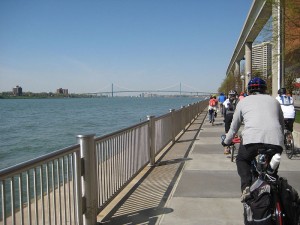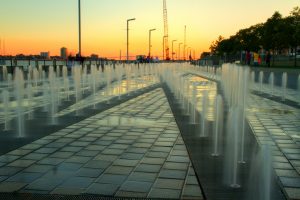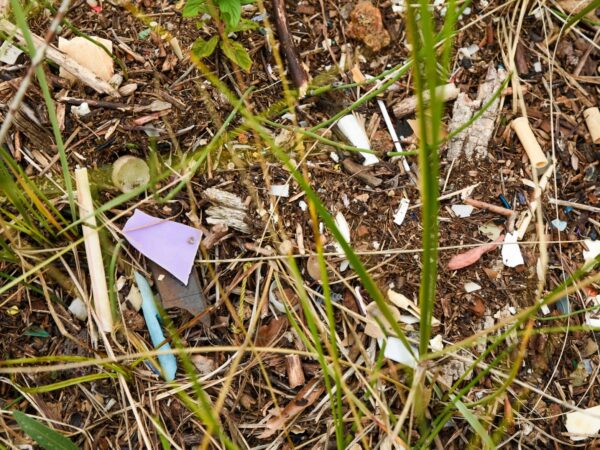
Telling our story: World-Class Natural Resources, Outdoor Recreation in Detroit’s Backyard
In January, Detroit got the bad news that it no longer was in contention for the $5 billion, second headquarters of Amazon – called “HQ2” – that would employ as many as 50,000 workers.
Almost everyone who loves Detroit was disappointed. Amazon cited a lack of talent and transportation as hindering Detroit’s bid. However, billionaire Detroit businessman Dan Gilbert, who was asked by Detroit Mayor Mike Duggan to lead the bid effort, disagrees and says the “elephant in the room” is the lingering, negative perception of Detroit.
Gilbert says the national and international perception of Detroit is still that of a Rust Belt city in economic, social, and environmental decline. He has called for a more balanced, full story of Detroit and our metropolitan region.
I believe that we must do a better job of telling our story.
Detroit has always been an international leader of paradigm shifts from the Fur Trade to becoming an unparalleled leader in ship building to putting the nation on wheels as the Motor City to becoming the unquestioned leader of the Arsenal of Democracy. Detroit has always been a city of innovation, resilience, and leadership in responding to paradigm shifts. The city now has the potential to lead the nation down a more sustainable path to address the sustainability paradigm shift.
Most major Metropolitan Detroit companies have already implemented best practices for sustainability and governments, environmental and conservation organizations, and businesses have been working for over four decades to improve our environment, restore our natural resources, and offer exceptional outdoor recreation. Compelling evidence includes:
- Bald eagles, peregrine falcons, osprey, lake sturgeon, lake whitefish, walleye, mayflies, and even beaver have returned to our Detroit River making it one of the most remarkable ecological recovery stories in North America;
- The Detroit River and western Lake Erie are situated at the intersection of the Atlantic and Mississippi Flyways with 30 species of waterfowl migrating through each year;
- Ducks Unlimited has identified Detroit as one of the top ten metropolitan areas for waterfowl hunting in the U.S.;
- Detroit Audubon has identified over 350 species of birds in the corridor;
- A ByWays to FlyWays Bird Driving Tour Map features 27 unique birding sites in southwest Ontario and southeast Michigan;
- The lower Detroit River is one of the three best places to watch raptor migrations in the U.S. and birders have seen over 100,000 raptors migrating in a single fall day;
- 113 species of fish have been found in the Detroit River and 10 million walleye ascend the Detroit River from Lake Erie each spring to spawn, creating an internationally renowned sport fishery that boosts our economy by millions of dollars;
- The Detroit River and western Lake Erie have been recognized for their biodiversity in the North American Waterfowl Management Plan, the United Nations Convention on Biological Diversity, and Western Hemispheric Shorebird Reserve Network;
- The Detroit River is the first river in North America to receive both American Heritage River and Canadian Heritage River designations;
- We are home to North America’s only international wildlife refuge – Detroit River International Wildlife Refuge;
- Southeast Michigan is blessed with over 210,000 acres of public parkland and conservation land;
- Belle Isle State Park, the crown-jewel of Detroit parks, is now the No. 1 most visited state park in the U.S.;
- Detroit has over 200 miles of greenway trails that are connected to over 800 miles of greenways in southeast Michigan;
- The Detroit RiverWalk is rapidly becoming the iconographic image of Detroit in the 21st Century with nearly three million annual visitors;
- The Detroit Heritage River Water Trail for paddling has been identified one of the “Top 11” water trails in Michigan;
- Michigan is 3rd in the nation in registered boats and about half are used on Lake St. Clair and the Detroit River; and
- Over 1,000 sail boat races held throughout the summer each year, including the prestigious Port Huron to Mackinac Race
Clearly, the Detroit Metropolitan Area has become an urban getaway for outdoor recreation. No longer do people have to drive five hours to get such a compelling, outdoor, recreational experience.
We need to do a better job of marketing our region as a leader of the sustainability paradigm shift with continentally-significant natural resources and world-class outdoor recreation right in our backyard. Our waters and other natural resources clearly give us competitive advantage to get people to stay here and move here to move the world!
Note from Great Lakes Bureau Chief Mary Ellen Geist: We are pleased to post the first story for greatlakesnow.org from Dr. John H. Hartig, who is currently a Fulbright Canada Research Chair in Global Governance at Balsillie School of International Affairs in Waterloo, Ontario. For the past 14 years he served as Refuge Manager for the Detroit River International Wildlife Refuge. John has received a number of awards for his work, including the 2017 Community Peacemaker Award from Wayne State University’s Center for Peace and Conflict Studies, the 2016 Edward G. Voss Conservation Science Award from Michigan Nature Association, the 2015 Conservationist of the Year Award from the John Muir Association, and the 2013 Conservation Advocate of the Year Award from the Michigan League of Conservation Voters. He has authored or co-authored over 100 publications on the environment, including four books: Bringing Conservation to Cities; Burning Rivers; Honoring Our Detroit River, Caring for Our Home; and Under RAPs: Toward Grassroots Ecological Democracy in the Great Lakes Basin. John’s most recent book titled Bringing Conservation to Cities won a Gold Medal from the Nonfiction Authors Association in the “Sustainable Living” category and a bronze medal from the Living Now Book Awards in the “Green Living” category. Hartig has agreed to become a regular contributor for DPTV’s Great Lakes Bureau greatlakesnow.org.







